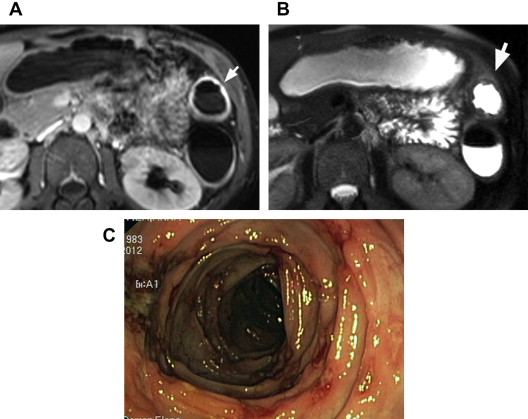MR colonography has a high diagnostic accuracy for detecting Crohn disease (CD) activity and determining the extent and severity of lesions. In the setting of stricturing CD, MR colonography can provide a detailed map of the lesions, which is useful for clinical decision making. MR colonography can be used as an alternative to conventional colonoscopy in the setting of CD, or as a complementary tool in selected patients with ulcerative colitis. This article reviews the spectrum of MR colonography findings in colonic inflammatory bowel disease and discusses the potential applications and limitations of MR colonography.
Key points
- •
MR colonography has a potential role as a complementary or alternative tool to colonoscopy for assessing the extension and severity of activity in inflammatory bowel disease, which is crucial in guiding therapy.
- •
MR colonography can be performed simultaneously with MR enterography, allowing the activity in both the large and small bowel to be evaluated in a single examination.
- •
MR colonography has a high accuracy for assessing the activity and severity of Crohn colitis; however, its performance in ulcerative colitis is less clear.
- •
MR colonography provides accurate information about transmural inflammation and Crohn disease–related complications, such as fistulas or abscesses, which is important for guiding therapy.
Introduction
In patients with inflammatory bowel disease (IBD), imaging techniques are useful to determine the location, extension, activity, and severity of lesions throughout the course of the disease. The information provided through imaging is crucial for establishing the therapeutic strategy for a particular patient and has prognostic implications.
Conventional colonoscopy is currently considered the reference standard for evaluating disease activity and severity in patients with IBD. However, colonoscopy is sometimes incomplete, and the information it provides is limited to the mucosal surface.
The diagnosis of IBD is based on a combination of clinical, laboratory, and histopathologic data. Therefore, an endoscopic evaluation of the colon and terminal ileum, including multiple biopsies, is needed to diagnose Crohn disease (CD) and ulcerative colitis (UC). However, in CD, lesions not only are confined to the inner wall surface but also involve other intestinal layers and the mesentery. Conventional colonoscopy cannot assess this transmural disease. Furthermore, colonoscopy is not always able to examine the entire colon, and other drawbacks include invasiveness, procedure-related discomfort, risk of bowel perforation, and relatively poor patient acceptance, especially the need for intense colonic cleansing. These disadvantages have led to the search for alternative imaging techniques to assess disease extension and severity in CD, including ultrasound, computed tomography (CT), and magnetic resonance (MR) imaging. Although ultrasound is widely available, totally noninvasive, and relatively inexpensive, it is limited by its high dependence on the expertise of the examiner and by the anatomic location of lesions. However, CT is operator-independent but exposes patients to ionizing radiation, limiting its usefulness, especially in younger patients, who must be reassessed on multiple occasions over the course of the disease.
MR colonography is highly accurate for assessing luminal inflammation, and provides useful information on disease activity, location, severity, and complications, particularly for penetrating and stricturing lesions, which are characteristic features of CD. This information is valuable for guiding medical and surgical treatment and maximizing efficacy and patient safety.
MR imaging has excellent tissular resolution, allowing it to identify inflammation. Unlike CT, MR imaging does not use ionizing radiation, and is associated with a lower incidence of intravenous contrast-related adverse events. Many recent studies have confirmed MR imaging’s critical role in assessing patients with CD, not only for evaluating disease activity but also for detecting small bowel lesions and disease-related complications. However, the role of MR imaging in assessing colonic involvement in CD has been investigated less extensively. Recent reports suggest that MR colonography can be useful for evaluating a variety of colonic disorders, including inflammatory diseases. MR colonography findings in patients with CD correlate well with those seen at colonoscopy and histopathology, especially for severe lesions.
Introduction
In patients with inflammatory bowel disease (IBD), imaging techniques are useful to determine the location, extension, activity, and severity of lesions throughout the course of the disease. The information provided through imaging is crucial for establishing the therapeutic strategy for a particular patient and has prognostic implications.
Conventional colonoscopy is currently considered the reference standard for evaluating disease activity and severity in patients with IBD. However, colonoscopy is sometimes incomplete, and the information it provides is limited to the mucosal surface.
The diagnosis of IBD is based on a combination of clinical, laboratory, and histopathologic data. Therefore, an endoscopic evaluation of the colon and terminal ileum, including multiple biopsies, is needed to diagnose Crohn disease (CD) and ulcerative colitis (UC). However, in CD, lesions not only are confined to the inner wall surface but also involve other intestinal layers and the mesentery. Conventional colonoscopy cannot assess this transmural disease. Furthermore, colonoscopy is not always able to examine the entire colon, and other drawbacks include invasiveness, procedure-related discomfort, risk of bowel perforation, and relatively poor patient acceptance, especially the need for intense colonic cleansing. These disadvantages have led to the search for alternative imaging techniques to assess disease extension and severity in CD, including ultrasound, computed tomography (CT), and magnetic resonance (MR) imaging. Although ultrasound is widely available, totally noninvasive, and relatively inexpensive, it is limited by its high dependence on the expertise of the examiner and by the anatomic location of lesions. However, CT is operator-independent but exposes patients to ionizing radiation, limiting its usefulness, especially in younger patients, who must be reassessed on multiple occasions over the course of the disease.
MR colonography is highly accurate for assessing luminal inflammation, and provides useful information on disease activity, location, severity, and complications, particularly for penetrating and stricturing lesions, which are characteristic features of CD. This information is valuable for guiding medical and surgical treatment and maximizing efficacy and patient safety.
MR imaging has excellent tissular resolution, allowing it to identify inflammation. Unlike CT, MR imaging does not use ionizing radiation, and is associated with a lower incidence of intravenous contrast-related adverse events. Many recent studies have confirmed MR imaging’s critical role in assessing patients with CD, not only for evaluating disease activity but also for detecting small bowel lesions and disease-related complications. However, the role of MR imaging in assessing colonic involvement in CD has been investigated less extensively. Recent reports suggest that MR colonography can be useful for evaluating a variety of colonic disorders, including inflammatory diseases. MR colonography findings in patients with CD correlate well with those seen at colonoscopy and histopathology, especially for severe lesions.
Colonic luminal inflammation in patients with CD
MR colonography findings in CD include ulcers, edema, wall thickening, hyperenhancement after intravenous contrast administration, engorgement of mesenteric vessels (comb sign), enlargement of perienteric lymph nodes, and stranding of mesenteric fat. When assessing activity in patients with CD, one must (1) confirm the presence of mural activity, (2) evaluate the severity of the lesions, and (3) rule out disease-related complications. These 3 aspects are crucial for establishing an optimal individualized therapeutic strategy.
Information about disease extension and activity has important prognostic implications and is essential for therapeutic recommendations. Confirmation of luminal activity in a patient with symptoms of a disease flare is crucial in the decision-making process. In 2 large clinical trials, 18% of patients with CD and moderate-to-severe symptoms had no evidence of ulceration at ileocolonoscopy. However, another study found that 40% of asymptomatic patients undergoing maintenance treatment with thiopurines had persistent inflammatory lesions.
Intestinal inflammatory changes may be found in various stages simultaneously. A focal patchy discontinuous asymmetrical distribution of abnormalities is a characteristic feature of CD. Some findings of active CD are erosions (aphthoid lesions) and small superficial ulcers. These lesions are easily observed on endoscopic examination but often remain undetected on MR colonography because they are flat.
MR colonography findings that correlate with active mucosal and mural inflammation include wall thickening, mural hyperenhancement, mural stratification, edema, ulcers, engorged vasa recta (comb sign), lymph node enlargement, and stranding of perienteric fat ( Fig. 1 ). However, systematic reviews of the literature and meta-analyses show that the most frequently used criteria are wall thickening and mural hyperenhancement. Multivariate analyses found that these 2 parameters were independent predictors of activity in different studies. The per-segment sensitivity of MR imaging in the assessment of colonic activity using these criteria was 70% (95% confidence interval [CI], 67%, 73%), whereas the per-segment specificity was 89% (95% CI, 83%, 96%). However, technical aspects may influence the sensitivity of MR colonography for detecting activity. Indirect data show that MR colonography is generally more accurate when the lumen of the colon is distended. Distending the colon improves the specificity of the technique and also allows better identification of superficial abnormalities, such us ulcerations that can be misread when the lumen is inadequately distended.

Increased wall thickness is observed in bowel segments with active CD. Most authors consider that with optimal luminal distension the colonic wall should be less than 3 mm thick, and any portion of the wall exceeding 3 mm is considered abnormal. No agreement exists regarding the normal colonic wall thickness without colonic distension. The degree of bowel wall thickening correlates with both endoscopic and pathologic indexes of CD severity, and wall thickening only occurs in the late fibrotic stages of the disease. In fact, in the early stages, mural thickening can occur from inflammatory cell infiltration of both the mucosa and submucosa layers. Another common finding in this setting is interstitial edema, which may partially explain wall thickening. Increased mural hyperenhancement is one of the most representative signs of active mural inflammation, even in the absence of wall thickening. Contrast hyperenhancement can be assessed through comparing thickened bowel segments with adjacent normal loops. The hyperenhancement can be transmural, mucosal, or layered. Whether these patterns of enhancement have any clinical difference is unclear. Mural hyperenhancement can be explained by the increased number of ectatic capillary vessels in the inflamed bowel wall. Caution is recommended in diagnosing active disease in the setting of suboptimal distension, because the mucosa in these cases may simulate hyperenhancement, leading to erroneous interpretations.
In general, MR colonography studies using negative luminal contrast show a higher accuracy for assessing colonic disease activity. The identification of engorged vasa recta that penetrate the bowel wall perpendicularly, known as the comb sign , is an unspecific feature of any inflammatory bowel process, but in the context of CD, it is a marker of colonic segments with active inflammation. This finding is associated with elevated C-reactive protein concentrations.
An intrinsic characteristic of CD is that the inflammatory changes may be found in various stages simultaneously, including segments with healing or regenerative changes. Patients with multiple or severe flare-ups may develop postinflammatory pseudopolyps during the regenerative phases in the sites where the inflammation is or was located. These finger-like or polypoid lesions protrude into the colonic lumen. The number of lesions is highly variable, ranging from isolated solitary lesions to multiple lesions with diffuse extension throughout the colon. The adjacent intestinal segments may show signs of inflammation with ulceration or quiescent CD features. Although they have no intrinsic malignant potential, large pseudopolyps can shelter dysplasia or carcinoma, and may be mistaken for neoplastic lesions on both endoscopy and MR colonography.
Finally, Oussalah and colleagues evaluated the accuracy of diffusion-weighted imaging (DWI) MR imaging without colonic preparation for assessing colonic inflammation in patients with CD, and found that DWI is nearly as accurate as the MR imaging morphologic findings for detecting activity, but the specificity of the high signal intensity seen in DWI is limited (nearly 60%).
Moderate-to-severe edema can be identified on MR imaging as wall hyperintensity on T2-weighted sequences; however, the absence of this finding cannot rule out active disease. Adding selective saturation of fat signal on T2-weighted sequences increases the sensitivity for identifying edema in the intestinal wall and perienteric fat.
Assessment of activity and severity in UC
Colonoscopy is the reference standard for evaluating and quantifying disease activity and extent in patients with UC. However, its invasiveness and poor acceptance by patients have prompted, although to a slightly less extent than in CD, the search for alternative or complementary cross-sectional imaging techniques, including MR colonography.
Although MR imaging has proven to be an excellent means of accurately assessing inflammatory changes in colonic CD, its utility in UC has been less extensively evaluated. The first study to indicate the usefulness of MR imaging in assessing UC was published in 1993, wherein wall thickening and hyperintensity of the mucosal and submucosal layers were identified as signs of active disease. Other investigators subsequently confirmed these findings.
MR Colonography Features of Activity and Chronicity in UC
UC is a chronic idiopathic inflammatory disease that involves the mucosa of the rectum and colon. Colorectal involvement is one feature that differentiates UC from CD. Characteristically, inflammation spreads proximally from the rectum into the colon to a variable extent in a continuous manner, without skipping areas, and therefore patients progress from proctitis to pancolitis. Rectosigmoid involvement is present in 95% of cases of UC, whereas pancolitis occurs in 35% to 45% of cases. Backwash ileitis is a rare condition (5% of cases) in which the terminal ileum is also involved in the context of pancolitis.
Most MR colonography parameters associated with UC colonic activity were shown to be closely correlated with the severity of endoscopic lesions, and significant differences ( P <.001) were found among segments with normal mucosa, mild-to-moderate lesions, and severe disease (except the comb sign, which was similar in mild-to-moderate and severe lesions).
Wall thickening, which is commonly associated with contrast enhancement, is less prominent in UC than in CD, regardless of the degree of severity. Differences in wall thickness between different degrees of severity are usually minimal (range, 1.0–1.2 mm), making simple visual assessment of severity in segments with active UC difficult. However, some patients with severe inflammation may present marked wall thickening.
Lastly, the reported rate of ulcers directly identified by MR colonography in UC is much lower (around 35%) than in CD. This difference is probably related to fact that involvement in UC is superficial. The ulcers in UC are usually more subtle than those in CD, and these alterations of the colonic wall are seen as a wavy configuration of the inner wall. In contrast, the outer contour of the wall is usually smoother and more regular in patients with UC than in those with CD, in whom irregular borders are usually seen.
Small amounts of pericolonic free fluid may be seen in cases of severe disease, and this finding indicates focal serosal involvement. Loss of haustra and luminal narrowing are common findings at endoscopy and MR colonography in long-standing inactive disease. Although it is conceivable why the colon wall becomes thickened in a transmural inflammatory disease such as CD, the mechanisms leading to this histologic finding remain unclear in UC, in which inflammation predominantly involves the mucosa. For unknown reasons, in long-standing UC the muscularis mucosa becomes hypertrophied, giving the lumen a typical tubular shape. The submucosa may also have fatty infiltration that contributes to segmental narrowing of some portions of the colon. Fatty proliferation in UC is typically limited to the perirectal space, producing an enlarged presacral space. Less frequently, fatty proliferation can be seen in the sigmoid colon and other colonic segments.
Stay updated, free articles. Join our Telegram channel

Full access? Get Clinical Tree





